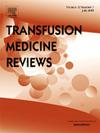超大量输血:澳大利亚和新西兰大量输血登记处(ANZ-MTR)的发生率和住院死亡率预测。
IF 2.5
2区 医学
Q2 HEMATOLOGY
引用次数: 0
摘要
超大量输血(UMT)是指在 48 小时内接受 20 个单位或更多的红细胞(RBC),有关超大量输血的患者临床特征、发生预测因素以及短期和长期结果的数据很少。本研究分析了澳大利亚和新西兰大量输血登记处(ANZ-MTR)的超大量输血事件。ANZ-MTR收集了29个参与地点所有接受大量输血(MT)的患者,大量输血的定义是在4小时内输注≥5个单位的红细胞。在 9028 名患者中,有 803 人(8.9%)接受了 UMT。UMT患者比其他MT患者更年轻(中位年龄为57岁 vs 62岁;P < .001)。在 UMT 和 MT 患者中,男性占多数(分别为 66.3% 和 62.9%);背景主要是创伤(分别为 28.8% 和 23%)和心胸外科(CTS)(分别为 21.7% 和 20.3%)。4 小时内收到的 RBC 单位中位数分别为 16 个(UMT)和 6 个(MT)。在 UMT 中,4 小时内 FFP:RBC 比率(0.6 vs 0.4,P < .001)和 4 小时内低温沉淀物使用率(72.9% vs 39.9%,P < .001)均较高。UMT 的独立预测因素(Odds Ratio; 95% CI)为年龄 100g/L (1.31;1.08-1.59)、INR >1.5 (1.56;1.24-1.96) 和 APTT >60s (4.49;3.40-5.61)。UMT 的院内死亡率预测因素包括 Charlson 生病指数评分≥3(11.20,0.60 - 25.00)和出血情况,与 CTS 相比,肝移植的死亡率较低(0.07,0.01-0.41),血管外科的死亡率较高(8.27,1.54-72.85)。与 MT 组相比,UMT 组的院内死亡率更高(20.5% vs 44.2%,P < .001),但出院后 5 年的存活率在两组间无显著差异(HR=0.87 [95%CI 0.64-1.18],P = .38)。与 MT 相比,UMT 患者通常更年轻,有基线凝血病,院内死亡率更高。然而,UMT 并非徒劳无益:55.8% 的患者存活至出院,两组患者出院后的存活率无明显差异。本文章由计算机程序翻译,如有差异,请以英文原文为准。
Ultra-Massive Transfusion: Predictors of Occurrence and In-Hospital mortality From the Australian and New Zealand Massive Transfusion Registry (ANZ-MTR)
Few data exist on patient clinical characteristics, predictors of occurrence and short- and long-term outcomes of ultra-massive transfusion (UMT), defined as receiving 20 units or more of red blood cells (RBCs) within 48h. This study analyses UMT events from the Australian and New Zealand Massive Transfusion Registry (ANZ-MTR). The ANZ-MTR captured all patients at 29 participating sites receiving a massive transfusion (MT), defined as ≥5 units of RBCs within 4h. Of 9028 patients, 803 (8.9%) received an UMT. UMT patients were younger than other MT patients (median age 57y vs 62y; P < .001). In UMT and MT, males predominated (66.3% and 62.9%, respectively); and context was predominantly trauma (28.8% and 23%) and cardiothoracic surgery (CTS) (21.7% and 20.3%). Median RBC units received within 4h were 16 (UMT) and 6 (MT). In UMT, 4h FFP:RBC ratio (0.6 vs 0.4, P < .001), and 4h cryoprecipitate use (72.9% vs 39.9%, P < .001) were higher. Independent predictors of UMT (Odds Ratio; 95% CI) were age <60y (1.52; 1.28-1.79), baseline Hb >100g/L (1.31; 1.08-1.59), INR >1.5 (1.56; 1.24-1.96), and APTT >60s (4.49; 3.40-5.61). Predictors of in-hospital mortality in UMT included Charlson Comorbidity Index score ≥3 (11.20, 0.60 - 25.00) and bleeding context, with mortality less likely in liver transplant (0.07, 0.01-0.41) and more likely in vascular surgery (8.27, 1.54-72.85), compared with CTS. In-hospital mortality was higher in the UMT group compared with MT group (20.5% vs 44.2%, P < .001), however 5y survival following discharge was not significantly different between the groups (HR=0.87 [95%CI 0.64-1.18], P = .38). UMT patients are more commonly younger, with baseline coagulopathy, and have higher in-hospital mortality compared with MT. However, UMT is not futile: 55.8% survived to discharge, without significant difference in survival postdischarge between the groups.
求助全文
通过发布文献求助,成功后即可免费获取论文全文。
去求助
来源期刊

Transfusion Medicine Reviews
医学-血液学
CiteScore
11.60
自引率
0.00%
发文量
40
审稿时长
21 days
期刊介绍:
Transfusion Medicine Reviews provides an international forum in English for the publication of scholarly work devoted to the various sub-disciplines that comprise Transfusion Medicine including hemostasis and thrombosis and cellular therapies. The scope of the journal encompasses basic science, practical aspects, laboratory developments, clinical indications, and adverse effects.
 求助内容:
求助内容: 应助结果提醒方式:
应助结果提醒方式:


